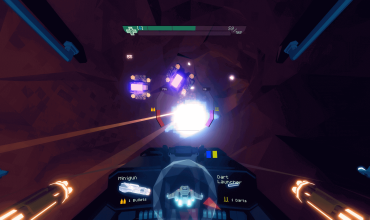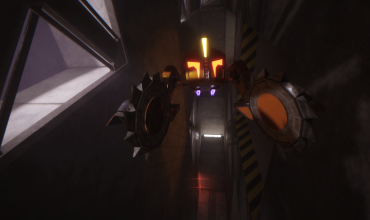“Wow” was my first thought upon seeing (and hearing) Sublevel Zero for the first time. I started Fists of Heaven because I feel that games, especially space games, transcend what we all usually think of when we think “game” and enter the realm of ‘playable art’. I felt that this art, and the individuals creating it, deserved recognition.
And Sublevel Zero is a work of art.
Roguelike: procedurally generated and randomized levels that are never the same twice
I’ve played every game released in the Six Degree of Freedom (6DoF) genre since it’s inception with Descent in 1994, which, unfortunately, amounts to less than a dozen titles total. Arguably the most difficult games to master, Sigtrap Games, the studio behind Sublevel Zero, decided to up the ante even further by adding two more layers of difficulty: Roguelike and Hardcore. Traditionally, I am against adding to an already massive learning curve, but in this case, I’d be wrong.
Hardcore: no save game – If you die, it’s game over for good.
In addition to the challenge of moving on on a multitude of planes (X, Y, Z, yaw, pitch, and roll) developers of 6DoF titles have the hurdle of designing and developing controls that make the player feel as though they are piloting a ship. Unlike the relatively simple ‘mouse-motion-to-game-look’ input that’s found in first person shooters, for example, the ships in 6DoF environments usually have mass, and thus a corresponding rotational acceleration and velocity.
To compound the developer’s difficulty, there are practically as many hardware input combinations as there are pilots. Some combination of two of the following is typically used, and none can be superior in order to appeal to the genre’s diehard audience and their preferences: joystick, mouse, keyboard, gamepad, rudder pedals, and more obscure devices such as 360 degree input hardware and others like the Logitech G13 and Razer Orbweaver. I personally use a mouse and the Logitech G13.
The ‘out of the box’ feel and design of Sublevel Zero’s controls (especially the mouse controls) is superb, making it as easy as is possible for new pilots.
Soundtrack
Composed by Will Bedford
Typically, gameplay and visuals receive the most attention, but I’d like to discuss Sublevel Zero’s soundtrack first. If I had double-clicked the game’s icon and had nothing happen except the soundtrack start playing, I would have been too spellbound to notice. In fact, I was spellbound: on my first solo play, I didn’t actually play for 45 minutes, instead, I sat at the menu screen completely enraptured by what my ears were experiencing. At the time I didn’t even know that in addition to the game, the music is also procedurally generated. I kept thinking “I swear this is changing subtly” but I thought it was temporary insanity induced by the title song.
Absolutely incredible.
It’s uncommon for a game to come with a soundtrack I know I’ll be listening to for the rest of my life. Will Bedford has made a name for himself in my short list of favorite game soundtrack composers that I listen to on a regular basis, right next to Paul Ruskay, Dan Wentz, Josh Whelchel and Brian Luzietti.
This is definitely not a slight on the gameplay or graphics, but the music is possibly my favorite thing about Sublevel Zero beyond the fact that it’s an incredibly well-made and well-polished 6DoF game. I felt the music really brought together the gameplay and the unique but immersive visuals. Will, my man – how did you do it, and what helped you make it happen? –Mike
I took a lot of inspiration from Gary’s art style. The low poly models and pixel art textures, combined with the organic cave structures and modern lighting effects inspired me to use a blend of retro and modern sounds.
Since every level is procedural, and therefore each playthrough is different, it was very important for Sublevel Zero to have a dynamic soundtrack. Firstly, the music has multiple combat/exploration layers which are interchanged to match the musical energy with the gameplay intensity. I also wanted to give each biome its own sonic identity, and have the music seamlessly adapt as the player moves through each level. To do this, I created different arrangements of every track to fit each environment. For example, the man-made/industrial rooms feature heavy drums, digital synths and chiptune sounds, while the organic cave structures have more emphasis on analog and orchestral instruments.
Overall, each level has 9 synchronised layers of music which fade in and out depending on various gameplay parameters. I assembled the dynamic music system in FMOD, and used some of my own custom tools to help with the musical arrangement. –Will
The Sublevel Zero soundtrack is a breathtaking collections of 8bit, modern, and classical sound ranging in diversity from violin, french horn, and chello solos to drum ‘n bass. There are tracks with aggressive electronic beats and those with melodic and orchestral epics (sometimes both in the same song!). This is an auditory pleasure trip you absolutely need to experience, so go purchase the DRM-free soundtrack here and download the uncompressed FLAC versions. Then, prepare to descend into 69 minutes of aural bliss.
Door. Key. Reactor.
Initially, it appears Sublevel Zero sticks to the gameplay style Descent created: each sublevel has a reactor you must destroy to move on to the next, but the reactors sure aren’t helpless. I don’t want to reveal any spoilers, but when I die in the game, it’s usually to a reactor. Sublevels don’t go down easily the first time around.
Pixel Perfect
Sublevel’s unique style jumps out here with the pixellated glow contrasting against the ‘lowfi’ cave system. It’s a look that’s as absolutely as unique and incredible as the gameplay and soundtrack.
How did this happen?
Sublevel Zero is so unique that I had to find out more. I asked Luke, the game’s lead programmer, the following in an effort to get an idea of how such a unique and creative combination of features all got put together so well:
You guys had the nads to not only make a 6DoF game (which I applaud you for!) but to make it even harder than a regular 6DoF by adding hardcore and roguelike elements, as well as some really unique RPG elements to the game. What went on in your minds when developing and executing this concept? –Mike
The overall design of the game came together from multiple places really. The core of the idea – a procedural Descent-like – came to myself, Phi (procedural coder) and Jey (sound designer) in the pub, quite a while ago now! Phi and Jey were just finishing up Phi’s first game, TinyKeep – a roguelike dungeon crawler. Over a couple of pints, we’d discovered we all loved Descent and Forsaken, and got talking about why such games weren’t around any more. Obviously, the idea of a 6DoF roguelike came up, which we all thought would be a great twist. Given we were all busy, we didn’t really think anything would come of the idea. A couple of months later however, the three of us had teamed up with Gary and Will for Ludum Dare, and the theme was – wait for it – “Beneath The Surface”! We couldn’t believe our luck, and mashed together the first incarnation of Sublevel Zero over three sleep-deprived days.
With the jam version done, and receiving a lot of praise, we decided to think seriously about SL0’s commercial prospects. From this, the rest of the design came together. Clearly the procedural generation aspect was a winner, but we wanted to really think about what systems would pull everything together into a complete, satisfying experience. Looting and crafting were the parts that completed the whole for us. Looting randomised weapons added to the excitement of the procedural systems, with the player being forced to adapt not only to new rooms and enemies, but choices of what weapons and modules to spend their inventory space on, and which to use in any given situation. Crafting on the other hand gave players a chance to take back some control from the randomisation, letting them choose what kind of build they wanted given the parts the game threw at them. We wanted to get a good mix of giving players new, surprising runs every time, while making sure they weren’t entirely at the whim of the RNG. –Luke
Random and Precious
Many aspects of the game, including the sublevel layout as well as the loot and weapons drop from bots and crates is completely random. In addition, everything is finite: energy, shield, missiles and ammo all deplete. More than once you’re going to be considering how many shots of what weapon(s) to expend on the enemy behind that next door. That feeling of isolation and self reliance has returned.
Sublevel Zero is full of tasteful audio, visual, and gameplay subleties, which I’ll leave up to you to discover.
I dig the art/graphics style, the ‘Descent I & II meet Tron’ look. Can you tell us a bit about the ‘story’ behind the look? –Mike
The art style was something we heavily iterated on throughout development and started off very experimental during the first few months. From our early concepts of the game, we wanted to go for a low-fi look with low-polygonal models and textures, inspired by visuals from games like Descent and Forsaken . As we started to develop the visuals, we gradually introduced more modern elements like as bloom, post-processing effects and volumetric lighting. The end result is a visually striking combination of old and new techniques that comes together and compliments the audio and musical direction.
Each biome in the game is designed to have their own unique elements, which stay within certain constraints for the visual style, whilst also presenting players with environments to fight in. You’ll notice that, in the first biome, the player encounters tight, almost claustrophobic spaces that can limit player movement as they get accustomed to the controls. As you progress these environments get larger, giving players more opportunity to approach fights, with alternate routes and areas. –Gary
Sublevel at Speed
Speed runs have become popular, with the current world record being held by my buddy Roncli. Spoiler alert for the video below:

Like FoH?
Fists of Heaven is ad-free and always will be. If you enjoyed the content above, help us out by sharing this post, or by commenting and letting us know what content you like and want to see more of. Thanks for reading!









